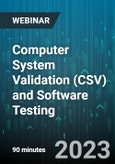Advancements in technology have forced organizations to rethink business models.
Once controlled and orderly, these organizations are now more chaotic and complex, serving patients and customers that are better informed and with higher expectations than ever before. Work practices and tools must change to meet these challenges.
The approach to developing software, performing validation, and maintaining a system in a validated state through its entire life cycle should be carefully considered in order to meet changing needs.
This webinar will include a comparison of the Agile and Waterfall methodologies, along with the pros and cons of each. There may not be one size that fits all, so it is important to understand what needs to be considered when making such a determination.
This approach is amenable to the Agile software development methodology, which can be adapted for use invalidation.
We will also discuss the important aspects of CSV and how to apply them in a new and modern technological environment.
Once controlled and orderly, these organizations are now more chaotic and complex, serving patients and customers that are better informed and with higher expectations than ever before. Work practices and tools must change to meet these challenges.
The approach to developing software, performing validation, and maintaining a system in a validated state through its entire life cycle should be carefully considered in order to meet changing needs.
This webinar will include a comparison of the Agile and Waterfall methodologies, along with the pros and cons of each. There may not be one size that fits all, so it is important to understand what needs to be considered when making such a determination.
Why you should Attend:
The attendee will learn about ways to modernize the System Development Life Cycle (SDLC) approach to Computer System Validation (CSV) by using automated testing tools that will result in a continuous validation of software products.This approach is amenable to the Agile software development methodology, which can be adapted for use invalidation.
We will also discuss the important aspects of CSV and how to apply them in a new and modern technological environment.
Areas Covered in the Session:
- Learn how to identify 'GxP' Systems
- Learn about FDA's current thinking about technology and software development, and how this will impact the industry
- Discuss the current state of the Computer System Validation (CSV) approach based on FDA requirements
- Learn about the System Development Life Cycle (SDLC) approach to validation and how this can be modernized through a more agile approach, including automated testing for continuous validation
- Learn the pros and cons of an Agile vs. Waterfall approach
- Learn about cloud computing and Software as a Service (SaaS) systems that can be embraced and validated effectively
- Understand the best practices for documenting computer system validation efforts, whether using a Waterfall or Agile approach, including requirements, design, development, testing, and operational maintenance procedures, including ways to improve efficiency and effectiveness of managing related documentation
- Understand how to maintain a system in a validated state through the system's entire life cycle in a more cost-effective manner, applying an Agile continuous validation approach
- Learn how to assure the integrity of data that supports GxP work, despite changes and advances in new technology
- Understand the importance of 'GxP' documentation that complies with FDA requirements
- Learn about the policies and procedures needed to support your validation process and ongoing maintenance of your systems in a validated state
- Know the regulatory influences that lead to FDA's current thinking at any given time
- Finally, understand the industry best practices that will enable you to optimize your approach to validation and compliance, based on risk assessment, to ensure data integrity is maintained throughout the entire data life cycle
- Q&A
Speaker
Carolyn (McKillop) Troiano has more than 35 years of experience in the tobacco, pharmaceutical, medical device and other FDA-regulated industries. She has worked directly, or on a consulting basis, for many of the larger pharmaceutical and tobacco companies in the US and Europe, developing and executing compliance strategies and programs. Carolyn is currently active in the Association of Information Technology Professionals (AITP), and Project Management Institute (PMI) chapters in the Richmond, VA area.During her career, Carolyn worked directly, or on a consulting basis, for many of the larger pharmaceutical companies in the US and Europe. She developed validation programs and strategies back in the mid-1980s, when the first FDA guidebook was published on the subject, and collaborated with FDA and other industry representatives on 21 CFR Part 11, the FDA's electronic record/electronic signature regulation.








